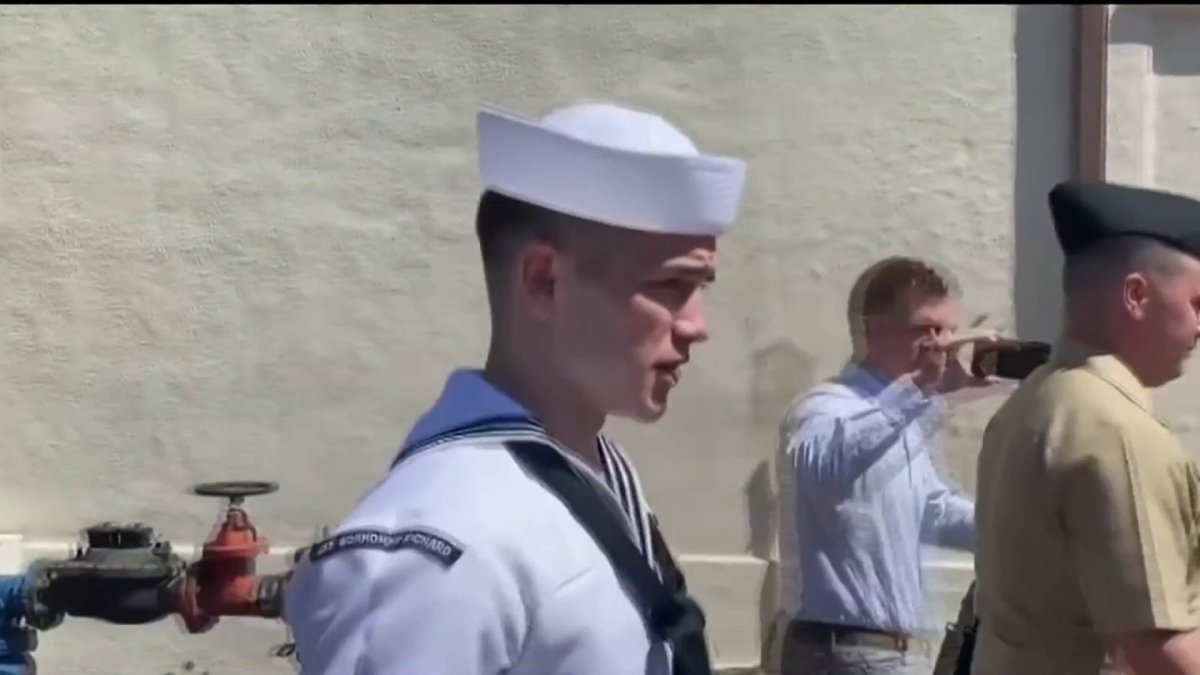
NBC 7’s Omari Fleming heard reaction to the case from the former defense attorney of the sailor standing trial.
A Navy sailor accused of setting a massive fire that burned for days and destroyed the USS Bonhomme Richard in San Diego pleaded not guilty to all charges against him and waived his right to a jury trial.
Seaman Recruit Ryan Sawyer Mays, 21, faces charges of arson and willful hazarding of a vessel for allegedly setting the blaze that began July 12, 2020, and burned for several days, sending a plume of dark smoke over the portside city while the warship was docked at Naval Base San Diego.
USS Bonhomme Richard
Mays, who is still on active duty, gave up the right to a trial by jury and chose to be tried by a military judge alone. The trial is expected to last two weeks and Mays faces up to life in prison if convicted.
Get San Diego local news, weather forecasts, sports and lifestyle stories to your inbox. Sign up for NBC San Diego newsletters.
He spoke briefly to NBC 7 during a break in proceedings Monday. "If you have any questions, feel free to contact my legal counsel but I just wanna say thanks guys, I appreciate you."
Prosecutors have alleged that Mays was "disgruntled" with the Navy after dropping out of the SEAL training program.
Cmdr. Leah O' Brien, for the prosecution, described the alleged arson in her opening statement as "a mischievous act of defiance gone wrong." After failing to become a Navy SEAL, Mays was assigned to the Bonhomme Richard's deck department, a job he had "a visceral hatred" for, she alleged.
The prosecutor said the ensuing investigation left "no doubt this fire was arson" and was most likely caused by touching an open flame to combustible material, as well as using an accelerant like paint thinner or gasoline.
Mays has denied any role in the fire, though other sailors previously testified to seeing him enter the ship's "Lower V" area -- where investigators say the fire originated -- just prior to the blaze breaking out. One of Mays' attorneys, Lt. Tayler Haggerty, said the prosecution was relying on a single witness who alleges he saw Mays.
Another sailor who escorted Mays to the brig after he was arrested alleged Mays admitted to setting the fire, though Haggerty contended Mays always maintained his innocence. The defense attorney claimed Mays said, "If I'm going to the brig, I guess I did it," and that investigators were using the statement against Mays "while ignoring the obvious sarcastic nature and context."
His defense team will attempt to cast doubt on the government's narrative on how the fire started. His lawyer made a motion Monday to include as evidence a fire that started 18 days before the Bonhomme Richard went up in flames. The lawyer argues it could prove there was another sailor who could have started the fire.
“As the defense pointed out in their opening statement, it appears that the government tried to hide that evidence during that course of the investigation. They knew about it but they never reported it," said former defense attorney Gary Barthel.
“I believe that the reason the Navy is using him as a scapegoat is they’re trying to deflect further negligence away from themselves, from the Navy. As you heard from some of the witnesses who testified today, that the Lower V became a dumping ground and there were a lot of things that were stored down there that should not have been stored down there,” said Barthel.
The attorney said this sailor, who was also disgruntled with the Navy, made internet searches just prior to the Bonhomme Richard blaze regarding "fire color heat scale" and could be linked to graffiti scrawled in portable toilets on and near the ship that read, "I did it. I set the ship on fire. (Expletive) the ship. 1 down, 3 to go."
At an Article 32 hearing held last year at the base, prosecutors alleged the blaze was sparked by someone touching an open flame to an ignitable liquid applied to tri-wall containers in the Lower V.
Defense expert witnesses challenged findings that the blaze was an incendiary -- or deliberate -- fire, and said further analysis of the scene should have been completed before investigators ruled out possible accidental causes of the blaze.
While Mays is the only person criminally charged in connection with the fire, the Navy issued a letter of censure earlier this year to the former commander of its U.S. Pacific Fleet, alleging leadership failures stemming from the fire, and also issued 27 "individual disposition decisions" regarding fire prevention, readiness and response efforts aboard the ship.